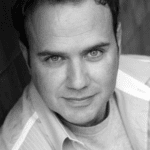Words, Dancing on My Skin

Anthony De Sa
July 2011
Her head was slightly tilted and her cigarette dangled from the corner of her mouth. She placed her ear close to the cool, green rind of a watermelon and knocked. She caught me staring. Her coral lips stretched wide to expose her yellow teeth. The cigarette didn’t fall—it just hung, tugging at her lower lip. She wasn’t thin but she was beautiful, and she had a sash to prove it—MISS SWEDEN 1951. Her large eyelashes flickered for only a moment before her fingers let the watermelon slip and fall onto the sidewalk. I heard the thud but saw only a beauty queen walk toward me as if in slow motion. Her gold-strapped heels cut through the splashing pulp and juice of the watermelon. Some of the glossy seeds stuck to her bare legs.
“I’m Kiki.” She extended her hand and smiled.
I felt the goose bumps rippling up my arms. Without hesitating I reached for her hand.
“Terezinha!” My mother yanked at my wrist. Kiki, immovable and smiling, straightened her back and adjusted her sash so that it crossed her cone-like breasts. I was pulled back into the fish market.
Published in TOK: Writing the New Toronto, Book 5. Purchase the book to read the full piece.
Toronto locations referenced in this piece
“We lived in a big house on Palmerston Avenue. It had to be big because my father always had friends or family live with us when they first came from the Azores to Canada. My mother said it was our way of helping out until they could do it on their own . . . ” —Palmerston Ave.
“Augusta Avenue was the main street where most Portuguese people shopped. We always called it ow-goo-shtah—that’s the way our parents pronounced it. Thursday was the day my mother had chosen to do our family groceries . . . ” —Augusta Ave.
“I saw Kiki feeding the pigeons in Bellevue Park, right across from the Portuguese Eaton’s, SASMART. We had been meeting here for a few weeks now, every Thursday . . . ” —Bellevue Park
“She led me through the crooked alleys of Baldwin Street and the narrow lane-ways that ran behind Kensington Avenue and Augusta Avenue. It was a different world, not like the brightly painted fronts . . . ” —Baldwin St.
“She led me through the crooked alleys of Baldwin Street and the narrow lane-ways that ran behind Kensington Avenue and Augusta Avenue. It was a different world, not like the brightly painted fronts . . . ” —Kensington Ave.
“I didn’t want to think too much about it. I ran across the park, toward Wales Avenue and a shortcut to the library. I looked back to see my mother looking at me. I waved and she disappeared . . . ” —Wales Ave.
“I quickly turned up Bellevue Avenue and made my way behind the synagogue. I didn’t know what to expect as I passed behind the dumpster and made my way up the stairs . . . ” —Bellevue Ave.
“I was yanked down the stairs into the sunlight, my eyes adjusting again as I moved around the dumpster and through the lane. We walked at a pounding pace and then slowed down when we came to Dundas and Bathurst . . . ” —Dundas & Bathurst
Recommended

Gaugin’s Chair
Shyam Selvadurai
Cranston woke into a bougainvillea-petalled morning, a rosy-fingered dawn of a morning. Soft, pinkish sunlight ... Read More

